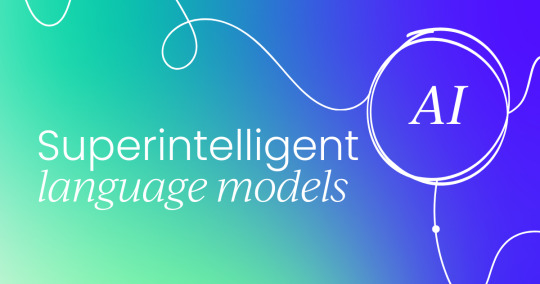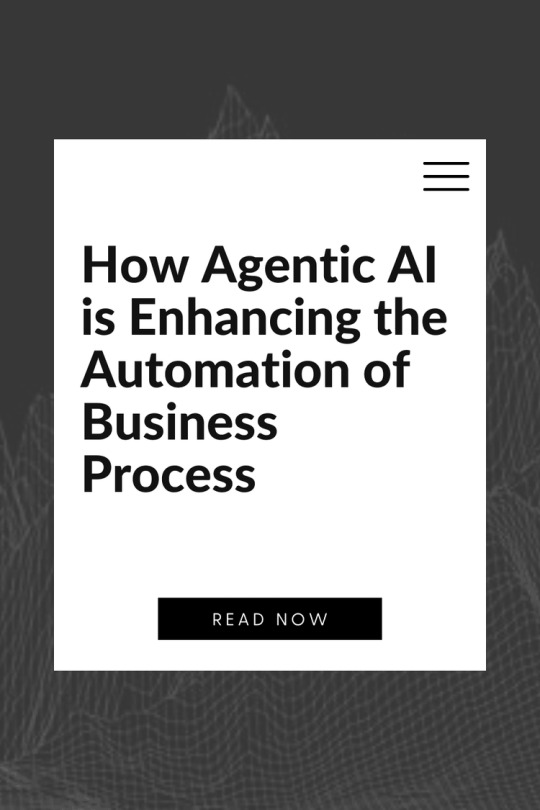#AI and ML in Business
Explore tagged Tumblr posts
Text
PGDM Specialization in AI & ML: Preparing for the Future of Business and Technology

#PG Diploma in AI and ML#Artificial Intelligence#Machine Learning#AI and ML in Business#AI and ML Career Opportunities#Career in Artificial Intelligence#Business and Technology#PGDM in AI and ML
2 notes
·
View notes
Text
The Digital Dairy: Transformative Power of AI/ML and IoT in Manufacturing
Uncover the revolutionary evolution of manufacturing with "The Digital Dairy," an illuminating exploration of the transformative synergy between AI/ML and IoT. Dive into the intricacies of how these cutting-edge technologies are reshaping the dairy industry, fostering efficiency, and optimizing production processes. Hosted on tntra.io, this insightful blog elucidates the powerful impact of AI/ML and IoT on manufacturing, offering a glimpse into the future of dairy production. Stay abreast of the latest trends and innovations that are propelling the industry forward, as experts dissect the seamless integration of artificial intelligence, machine learning, and the Internet of Things in this dynamic sector.
0 notes
Text
Top 10 Free AI Video Maker Tools to Create Stunning Videos in 2025
Top 10 Free AI Video Maker Tools to Create Stunning Videos in 2025 As we step into 2025, video content continues to dominate the digital landscape. From social media platforms to corporate presentations, videos are the most engaging way to communicate ideas, tell stories, and promote products. However, creating high-quality videos traditionally required expensive software, professional skills,…
#AI face swap#AI video editor#AI video maker#AI-generated videos#auto-subtitles#background remover#content creation#creative storytelling#DeepBrain#educational videos#explainer videos#FlexClip#free video editing#free video maker tools#InVideo#Lumen5#marketing videos#multilingual videos#Pictory#professional video tools#RawShorts#Runway ML#social media videos#Synthesia#text-to-video#Veed.io#video collaboration#video creation software#video editing tools#video for businesses
2 notes
·
View notes
Text
One of my teammates altered the formating for how some data is stored for this project and thats fine its so totally fine cause it's lowkey an improvement i think but now I've spent the last 4 hours fixing everything else and i still have stuff to fix and oh my god i hate this project sm
#get me out of app dev hell i signed up for a datascience ml/ai project not this fucking bullshit#im so sick of business people not understanding ai man theres no fucking ai in this project they just wanted to slap the buzz word on it#to be trendy#the clients are lovely dont get me wrong but they have no technical knowledge whatsoever and it's bit us in the ass all year#personal
2 notes
·
View notes
Text
Boost E-commerce in Saudi Arabia with ML-Powered Apps

In today's digital era, the e-commerce industry in Saudi Arabia is rapidly expanding, fueled by increasing internet penetration and a tech-savvy population. To stay competitive, businesses are turning to advanced technologies, particularly Machine Learning (ML), to enhance user experiences, optimize operations, and drive growth. This article explores how ML is transforming the e-commerce landscape in Saudi Arabia and how businesses can leverage this technology to boost their success.
The Current E-commerce Landscape in Saudi Arabia
The e-commerce market in Saudi Arabia has seen exponential growth over the past few years. With a young population, widespread smartphone usage, and supportive government policies, the Kingdom is poised to become a leading e-commerce hub in the Middle East. Key players like Noon, Souq, and Jarir have set the stage, but the market is ripe for innovation, especially with the integration of Machine Learning.
The Role of Machine Learning in E-commerce
Machine Learning, a subset of Artificial Intelligence (AI), involves the use of algorithms to analyze data, learn from it, and make informed decisions. In e-commerce, ML enhances various aspects, from personalization to fraud detection. Machine Learning’s ability to analyze large datasets and identify trends is crucial for businesses aiming to stay ahead in a competitive market.
Personalized Shopping Experiences
Personalization is crucial in today’s e-commerce environment. ML algorithms analyze user data, such as browsing history and purchase behavior, to recommend products that align with individual preferences. This not only elevates the customer experience but also drives higher conversion rates. For example, platforms that leverage ML for personalization have seen significant boosts in sales, as users are more likely to purchase items that resonate with their interests.
Optimizing Inventory Management
Effective inventory management is critical for e-commerce success. ML-driven predictive analytics can forecast demand with high accuracy, helping businesses maintain optimal inventory levels. This minimizes the chances of overstocking or running out of products, ensuring timely availability for customers. E-commerce giants like Amazon have successfully implemented ML to streamline their inventory management processes, setting a benchmark for others to follow.
Dynamic Pricing Strategies
Price is a major factor influencing consumer decisions. Machine Learning enables real-time dynamic pricing by assessing market trends, competitor rates, and customer demand. This allows businesses to adjust their prices to maximize revenue while remaining competitive. Dynamic pricing, powered by ML, has proven effective in attracting price-sensitive customers and increasing overall profitability.
Enhanced Customer Support
Customer support is another area where ML shines. AI-powered chatbots and virtual assistants can handle a large volume of customer inquiries, providing instant responses and resolving issues efficiently. This not only improves customer satisfaction but also reduces the operational costs associated with maintaining a large support team. E-commerce businesses in Saudi Arabia can greatly benefit from incorporating ML into their customer service strategies.
Fraud Detection and Security
With the rise of online transactions, ensuring the security of customer data and payments is paramount. ML algorithms can detect fraudulent activities by analyzing transaction patterns and identifying anomalies. By implementing ML-driven security measures, e-commerce businesses can protect their customers and build trust, which is essential for long-term success.
Improving Marketing Campaigns
Effective marketing is key to driving e-commerce success. ML can analyze customer data to create targeted marketing campaigns that resonate with specific audiences. It enhances the impact of marketing efforts, leading to improved customer engagement and higher conversion rates. Successful e-commerce platforms use ML to fine-tune their marketing strategies, ensuring that their messages reach the right people at the right time.
Case Study: Successful E-commerce Companies in Saudi Arabia Using ML
Several e-commerce companies in Saudi Arabia have already begun leveraging ML to drive growth. For example, Noon uses ML to personalize the shopping experience and optimize its supply chain, leading to increased customer satisfaction and operational efficiency. These companies serve as examples of how ML can be a game-changer in the competitive e-commerce market.
Challenges of Implementing Machine Learning in E-commerce
While the benefits of ML are clear, implementing this technology in e-commerce is not without challenges. Technical hurdles, such as integrating ML with existing systems, can be daunting. Additionally, there are concerns about data privacy, particularly in handling sensitive customer information. Businesses must address these challenges to fully harness the power of ML.
Future Trends in Machine Learning and E-commerce
As ML continues to evolve, new trends are emerging that will shape the future of e-commerce. For instance, the integration of ML with augmented reality (AR) offers exciting possibilities, such as virtual try-ons for products. Businesses that stay ahead of these trends will be well-positioned to lead the market in the coming years.
Influence of Machine Learning on Consumer Behavior in Saudi Arabia
ML is already influencing consumer behavior in Saudi Arabia, with personalized experiences leading to increased customer loyalty. As more businesses adopt ML, consumers can expect even more tailored shopping experiences, further enhancing their satisfaction and engagement.
Government Support and Regulations
The Saudi government is proactively encouraging the integration of cutting-edge technologies, including ML, within the e-commerce industry. Through initiatives like Vision 2030, the government aims to transform the Kingdom into a global tech hub. However, businesses must also navigate regulations related to data privacy and AI to ensure compliance.
Conclusion
Machine Learning is revolutionizing e-commerce in Saudi Arabia, offering businesses new ways to enhance user experiences, optimize operations, and drive growth. By embracing ML, e-commerce companies can not only stay competitive but also set new standards in the industry. The future of e-commerce in Saudi Arabia is bright, and Machine Learning will undoubtedly play a pivotal role in shaping its success.
FAQs
How does Machine Learning contribute to the e-commerce sector? Machine Learning enhances e-commerce by improving personalization, optimizing inventory, enabling dynamic pricing, and enhancing security.
How can Machine Learning improve customer experiences in e-commerce? ML analyzes user data to provide personalized recommendations, faster customer support, and tailored marketing campaigns, improving overall satisfaction.
What are the challenges of integrating ML in e-commerce? Challenges include technical integration, data privacy concerns, and the need for skilled professionals to manage ML systems effectively.
Which Saudi e-commerce companies are successfully using ML? Companies like Noon and Souq are leveraging ML for personalized shopping experiences, inventory management, and customer support.
What is the future of e-commerce with ML in Saudi Arabia? The future looks promising with trends like ML-driven AR experiences and more personalized
#machine learning e-commerce#Saudi Arabia tech#ML-powered apps#e-commerce growth#AI in retail#customer experience Saudi Arabia#digital transformation Saudi#ML app benefits#AI-driven marketing#predictive analytics retail#Saudi digital economy#e-commerce innovation#smart retail solutions#AI tech adoption#machine learning in business
2 notes
·
View notes
Text
Statistical Tools
Daily writing promptWhat was the last thing you searched for online? Why were you looking for it?View all responses Checking which has been my most recent search on Google, I found that I asked for papers, published in the last 5 years, that used a Montecarlo method to check the reliability of a mathematical method to calculate a team’s efficacy. Photo by Andrea Piacquadio on Pexels.com I was…

View On WordPress
#Adjusted R-Squared#Agile#AI#AIC#Akaike Information Criterion#Akaike Information Criterion (AIC)#Algorithm#algorithm design#Analysis#Artificial Intelligence#Bayesian Information Criterion#Bayesian Information Criterion (BIC)#BIC#Business#Coaching#consulting#Cross-Validation#dailyprompt#dailyprompt-2043#Goodness of Fit#Hypothesis Testing#inputs#Machine Learning#Mathematical Algorithm#Mathematics#Mean Squared Error#ML#Model Selection#Monte Carlo#Monte Carlo Methods
2 notes
·
View notes
Text
3 notes
·
View notes
Text
youtube
#connectinfosofttechnologies#connectinfosoft#ArtificialIntelligence#MachineLearning#AI#ML#WebDesign#SaaS#MobileApps#WebDevelopment#SoftwareAsAService#AppDevelopment#CuttingEdgeTech#DigitalAgency#TechPartner#BusinessSolutions#softwaredevelopment#webdevelopment#Trending#Trendingshorts#techtrend#reels#ITConsultant#ITCompany#ITIndustry#ITServices#Outsourcing#technology#Innovation#Business
3 notes
·
View notes
Text
How Poscig Technologies Builds Fast, Secure, and Scalable Websites for Any Business

In the digital age, a website is more than just a business card it’s the foundation of your online presence. But for it to truly deliver results, it must be fast, secure, and scalable. This is where expert-level web development services come into play.
At Poscig Technologies, we go beyond aesthetics. As a leading web development company in Pune, India, we help businesses build performance-driven websites that are built to convert, scale, and protect.
Here’s how we ensure our clients stay ahead in the digital game.
Why Website Speed Matters?
Website visitors today expect lightning-fast experiences. Research shows that a 1-second delay in page load time can cut conversions by 7%, and over half of users abandon sites that take more than 3 seconds to load.
Speed also plays a major role in Google’s Core Web Vitals a key SEO ranking factor.
At Poscig Technologies, our web development services include:
Writing clean, minimal, and SEO-friendly code
Image compression techniques to reduce load time
Integration of global Content Delivery Networks (CDNs)
This ensures every website we build loads quickly, ranks well, and keeps users engaged.
Building Secure Websites
In today’s threat landscape, security isn’t optional — it’s critical. As a trusted provider of web development services in Pune, India, we embed security into every layer of your website’s architecture.
Here’s what we implement:
SSL certificates for secure data encryption
Secure frameworks like Laravel and Next.js
Regular vulnerability scans and code audits
Role-based access controls and authentication systems
Our goal? To ensure your business is protected from data breaches, phishing, and malware.

Scalable Architecture for Future Growth

As your business grows, so should your website — without the need to rebuild it from scratch.
At Poscig Technologies, we specialize in scalable web development services. Our approach includes:
Modular and component-based coding
Optimized database structures
Cloud-based deployments using AWS, DigitalOcean, and more
Tech Stack and Tools That Power Our Success
To deliver top-tier solutions, we rely on the most modern and secure tools available:
Frontend: React, Next.js, Vue.js
Backend: Laravel, Node.js
Deployment Platforms: AWS, DigitalOcean, Vercel
DevOps: CI/CD pipelines for smooth updates and no downtime
This stack allows us to offer web development services that are not just high-performing, but also easy to maintain and expand.

Why Businesses Choose Poscig Technologies

Working with a best design company like Poscig Technologies means getting more than just a website — you get a digital platform built to grow and evolve with your business.
Faster websites increase engagement and drive conversions
Secure platforms reduce risk and build trust
Scalable solutions future-proof your online presence
Conclusion
In a world where digital expectations are constantly rising, having a visually attractive website is just the beginning. The real value lies in building a website that is fast, secure, and scalable — and that’s exactly what we do at Poscig Technologies.
If you’re looking for web development services in Pune, India, and want to work with a best design company that understands performance, security, and growth — we’re here to help.

#software development company in india#top software development companies#ai ml development company#business intelligence services#mobile app development company in pune#web development company in pune#cyber security services in pune#staff augmentation company in pune#website development company in pune##android app development company#cyber security management services#wordpress website development services#custom software development services
0 notes
Text
CAP theorem in ML: Consistency vs. availability
New Post has been published on https://thedigitalinsider.com/cap-theorem-in-ml-consistency-vs-availability/
CAP theorem in ML: Consistency vs. availability

The CAP theorem has long been the unavoidable reality check for distributed database architects. However, as machine learning (ML) evolves from isolated model training to complex, distributed pipelines operating in real-time, ML engineers are discovering that these same fundamental constraints also apply to their systems. What was once considered primarily a database concern has become increasingly relevant in the AI engineering landscape.
Modern ML systems span multiple nodes, process terabytes of data, and increasingly need to make predictions with sub-second latency. In this distributed reality, the trade-offs between consistency, availability, and partition tolerance aren’t academic — they’re engineering decisions that directly impact model performance, user experience, and business outcomes.
This article explores how the CAP theorem manifests in AI/ML pipelines, examining specific components where these trade-offs become critical decision points. By understanding these constraints, ML engineers can make better architectural choices that align with their specific requirements rather than fighting against fundamental distributed systems limitations.
Quick recap: What is the CAP theorem?
The CAP theorem, formulated by Eric Brewer in 2000, states that in a distributed data system, you can guarantee at most two of these three properties simultaneously:
Consistency: Every read receives the most recent write or an error
Availability: Every request receives a non-error response (though not necessarily the most recent data)
Partition tolerance: The system continues to operate despite network failures between nodes
Traditional database examples illustrate these trade-offs clearly:
CA systems: Traditional relational databases like PostgreSQL prioritize consistency and availability but struggle when network partitions occur.
CP systems: Databases like HBase or MongoDB (in certain configurations) prioritize consistency over availability when partitions happen.
AP systems: Cassandra and DynamoDB favor availability and partition tolerance, adopting eventual consistency models.
What’s interesting is that these same trade-offs don’t just apply to databases — they’re increasingly critical considerations in distributed ML systems, from data pipelines to model serving infrastructure.
The great web rebuild: Infrastructure for the AI agent era
AI agents require rethinking trust, authentication, and security—see how Agent Passports and new protocols will redefine online interactions.

Where the CAP theorem shows up in ML pipelines
Data ingestion and processing
The first stage where CAP trade-offs appear is in data collection and processing pipelines:
Stream processing (AP bias): Real-time data pipelines using Kafka, Kinesis, or Pulsar prioritize availability and partition tolerance. They’ll continue accepting events during network issues, but may process them out of order or duplicate them, creating consistency challenges for downstream ML systems.
Batch processing (CP bias): Traditional ETL jobs using Spark, Airflow, or similar tools prioritize consistency — each batch represents a coherent snapshot of data at processing time. However, they sacrifice availability by processing data in discrete windows rather than continuously.
This fundamental tension explains why Lambda and Kappa architectures emerged — they’re attempts to balance these CAP trade-offs by combining stream and batch approaches.
Feature Stores
Feature stores sit at the heart of modern ML systems, and they face particularly acute CAP theorem challenges.
Training-serving skew: One of the core features of feature stores is ensuring consistency between training and serving environments. However, achieving this while maintaining high availability during network partitions is extraordinarily difficult.
Consider a global feature store serving multiple regions: Do you prioritize consistency by ensuring all features are identical across regions (risking unavailability during network issues)? Or do you favor availability by allowing regions to diverge temporarily (risking inconsistent predictions)?
Model training
Distributed training introduces another domain where CAP trade-offs become evident:
Synchronous SGD (CP bias): Frameworks like distributed TensorFlow with synchronous updates prioritize consistency of parameters across workers, but can become unavailable if some workers slow down or disconnect.
Asynchronous SGD (AP bias): Allows training to continue even when some workers are unavailable but sacrifices parameter consistency, potentially affecting convergence.
Federated learning: Perhaps the clearest example of CAP in training — heavily favors partition tolerance (devices come and go) and availability (training continues regardless) at the expense of global model consistency.
Model serving
When deploying models to production, CAP trade-offs directly impact user experience:
Hot deployments vs. consistency: Rolling updates to models can lead to inconsistent predictions during deployment windows — some requests hit the old model, some the new one.
A/B testing: How do you ensure users consistently see the same model variant? This becomes a classic consistency challenge in distributed serving.
Model versioning: Immediate rollbacks vs. ensuring all servers have the exact same model version is a clear availability-consistency tension.
Superintelligent language models: A new era of artificial cognition
The rise of large language models (LLMs) is pushing the boundaries of AI, sparking new debates on the future and ethics of artificial general intelligence.

Case studies: CAP trade-offs in production ML systems
Real-time recommendation systems (AP bias)
E-commerce and content platforms typically favor availability and partition tolerance in their recommendation systems. If the recommendation service is momentarily unable to access the latest user interaction data due to network issues, most businesses would rather serve slightly outdated recommendations than no recommendations at all.
Netflix, for example, has explicitly designed its recommendation architecture to degrade gracefully, falling back to increasingly generic recommendations rather than failing if personalization data is unavailable.
Healthcare diagnostic systems (CP bias)
In contrast, ML systems for healthcare diagnostics typically prioritize consistency over availability. Medical diagnostic systems can’t afford to make predictions based on potentially outdated information.
A healthcare ML system might refuse to generate predictions rather than risk inconsistent results when some data sources are unavailable — a clear CP choice prioritizing safety over availability.
Edge ML for IoT devices (AP bias)
IoT deployments with on-device inference must handle frequent network partitions as devices move in and out of connectivity. These systems typically adopt AP strategies:
Locally cached models that operate independently
Asynchronous model updates when connectivity is available
Local data collection with eventual consistency when syncing to the cloud
Google’s Live Transcribe for hearing impairment uses this approach — the speech recognition model runs entirely on-device, prioritizing availability even when disconnected, with model updates happening eventually when connectivity is restored.
Strategies to balance CAP in ML systems
Given these constraints, how can ML engineers build systems that best navigate CAP trade-offs?
Graceful degradation
Design ML systems that can operate at varying levels of capability depending on data freshness and availability:
Fall back to simpler models when real-time features are unavailable
Use confidence scores to adjust prediction behavior based on data completeness
Implement tiered timeout policies for feature lookups
DoorDash’s ML platform, for example, incorporates multiple fallback layers for their delivery time prediction models — from a fully-featured real-time model to progressively simpler models based on what data is available within strict latency budgets.
Hybrid architectures
Combine approaches that make different CAP trade-offs:
Lambda architecture: Use batch processing (CP) for correctness and stream processing (AP) for recency
Feature store tiering: Store consistency-critical features differently from availability-critical ones
Materialized views: Pre-compute and cache certain feature combinations to improve availability without sacrificing consistency
Uber’s Michelangelo platform exemplifies this approach, maintaining both real-time and batch paths for feature generation and model serving.
Consistency-aware training
Build consistency challenges directly into the training process:
Train with artificially delayed or missing features to make models robust to these conditions
Use data augmentation to simulate feature inconsistency scenarios
Incorporate timestamp information as explicit model inputs
Facebook’s recommendation systems are trained with awareness of feature staleness, allowing the models to adjust predictions based on the freshness of available signals.
Intelligent caching with TTLs
Implement caching policies that explicitly acknowledge the consistency-availability trade-off:
Use time-to-live (TTL) values based on feature volatility
Implement semantic caching that understands which features can tolerate staleness
Adjust cache policies dynamically based on system conditions
How to build autonomous AI agent with Google A2A protocol
How to build autonomous AI agent with Google A2A protocol, Google Agent Development Kit (ADK), Llama Prompt Guard 2, Gemma 3, and Gemini 2.0 Flash.

Design principles for CAP-aware ML systems
Understand your critical path
Not all parts of your ML system have the same CAP requirements:
Map your ML pipeline components and identify where consistency matters most vs. where availability is crucial
Distinguish between features that genuinely impact predictions and those that are marginal
Quantify the impact of staleness or unavailability for different data sources
Align with business requirements
The right CAP trade-offs depend entirely on your specific use case:
Revenue impact of unavailability: If ML system downtime directly impacts revenue (e.g., payment fraud detection), you might prioritize availability
Cost of inconsistency: If inconsistent predictions could cause safety issues or compliance violations, consistency might take precedence
User expectations: Some applications (like social media) can tolerate inconsistency better than others (like banking)
Monitor and observe
Build observability that helps you understand CAP trade-offs in production:
Track feature freshness and availability as explicit metrics
Measure prediction consistency across system components
Monitor how often fallbacks are triggered and their impact
Wondering where we’re headed next?
Our in-person event calendar is packed with opportunities to connect, learn, and collaborate with peers and industry leaders. Check out where we’ll be and join us on the road.
AI Accelerator Institute | Summit calendar
Unite with applied AI’s builders & execs. Join Generative AI Summit, Agentic AI Summit, LLMOps Summit & Chief AI Officer Summit in a city near you.

#agent#Agentic AI#agents#ai#ai agent#AI Engineering#ai summit#AI/ML#amp#applications#applied AI#approach#architecture#Article#Articles#artificial#Artificial General Intelligence#authentication#autonomous#autonomous ai#awareness#banking#Behavior#Bias#budgets#Business#cache#Calendar#Case Studies#challenge
0 notes
Text
#artificial intelligence services#machine learning solutions#AI development company#machine learning development#AI services India#AI consulting services#ML model development#custom AI solutions#deep learning services#natural language processing#computer vision solutions#AI integration services#AI for business#enterprise AI solutions#machine learning consulting#predictive analytics#AI software development#intelligent automation
0 notes
Text

How Agentic AI is Enhancing the Automation of Business Process
Artificial Intelligence (AI) is revolutionizing industries across the globe, with business process automation (BPA) being one of its most significant beneficiaries. Traditional automation has focused on rule-based systems that execute predefined tasks. However, the advent of Agentic AI—AI that is autonomous, adaptive, and capable of decision-making—has ushered in a new era of intelligent automation.
What is Agentic AI?
Agentic AI refers to AI systems that exhibit agency, meaning they can perform tasks with minimal human intervention, adapt to new situations, and make decisions based on complex data inputs. Unlike traditional automation, which follows a rigid, rules-based approach, Agentic AI can:
Learn from experience: Continually refine its processes based on new data.
Make autonomous decisions: Reduce reliance on human oversight.
Adapt dynamically: Respond to changing business conditions in real-time.
Communicate and collaborate: Work alongside human employees and other AI agents.
This ability to act independently makes Agentic AI a game-changer in business process automation.

The Role of Agentic AI in Business Process Automation
1. Enhanced Decision-Making
Agentic AI allows businesses to move beyond simple task automation to intelligent decision-making. By analyzing vast amounts of data, AI-driven automation can identify patterns, predict outcomes, and optimize processes without requiring constant human input. This is particularly valuable in sectors like finance, healthcare, and supply chain management.
For example, in the financial sector, AI algorithms analyze market trends, detect fraud, and automate loan approvals based on customer credit history, reducing the need for manual assessments.
2. Hyper-Automation
Hyper-automation, a key trend in BPA, involves integrating AI with robotic process automation (RPA) to create fully automated workflows. Agentic AI enhances this by:
Enabling bots to handle complex scenarios rather than just repetitive tasks.
Making real-time adjustments based on external factors.
Reducing the need for manual intervention in high-stakes decision-making.
Businesses implementing hyper-automation can achieve unparalleled efficiency and scalability, minimizing human effort while improving accuracy.
3. Personalized Customer Experiences
Businesses are increasingly using AI-driven automation to provide tailored customer experiences. Agentic AI can:
Analyze customer interactions to predict needs and preferences.
Provide personalized product recommendations.
Automate customer service through AI-driven chatbots and virtual assistants.
For instance, AI-powered recommendation engines used by companies like Amazon and Netflix analyze user behaviour to offer personalized content, leading to increased engagement and customer satisfaction.
4. Operational Efficiency & Cost Reduction
With Agentic AI handling repetitive and decision-intensive tasks, businesses can:
Reduce operational costs by minimizing human labour in routine processes.
Improve accuracy and efficiency by eliminating human errors.
Scale operations without a proportional increase in workforce expenses.
This translates into increased profitability and allows human employees to focus on more strategic and creative tasks.
5. Supply Chain & Logistics Optimization
Agentic AI is revolutionizing logistics by dynamically adjusting supply chain operations based on real-time data. Benefits include:
Predictive inventory management, reducing stock shortages and overstocking.
Optimized route planning for deliveries, cutting down transportation costs.
Automated procurement processes that respond to demand fluctuations.
For example, AI-driven logistics platforms like Amazon’s fulfillment centers use AI to streamline inventory management and warehouse operations, significantly reducing delays and costs.
Real-World Applications of Agentic AI in BPA
Banking & Finance
AI-driven risk assessment and fraud detection systems improve security.
Automated financial advisory services assist clients with investments.
Loan processing is accelerated using AI-powered credit risk assessment models.
Healthcare
AI assists in diagnosing diseases with greater accuracy.
Automated administrative processes, such as patient scheduling, streamline hospital operations.
Personalized treatment plans are generated using predictive analytics.
Retail & E-commerce
AI optimizes pricing strategies based on demand trends.
Automated supply chain management ensures product availability.
Personalized marketing campaigns increase conversion rates.
Manufacturing
Predictive maintenance minimizes equipment downtime.
AI optimizes production schedules to reduce waste and improve efficiency.
Automated quality control detects defects faster than human inspectors.
Human Resources
AI-driven recruitment tools analyze resumes and match candidates with job roles.
Automated onboarding enhances employee engagement.
AI monitors workforce productivity and suggests improvements.
“Moving beyond static workflows, Agentic AI revolutionizes business process automation by embedding adaptive decision-making at every step. This breakthrough not only automates tasks but continuously refines how businesses operate.”
— Michael Roberts, Senior VP of Digital Operations at Innovare Systems
How to Implement Agentic AI in Your Business
Implementing Agentic AI in business process automation requires careful planning and execution. Below are the key steps to successfully integrate AI-driven automation:
1. Identify Business Needs and Goals
Assess areas where automation can add the most value, such as improving customer service, streamlining operations, or reducing costs.
Define clear objectives for AI implementation, such as increasing efficiency, accuracy, or scalability.
2. Select the Right AI Tools and Technologies
Evaluate AI platforms and solutions that align with your business needs.
Consider cloud-based AI services for scalability and ease of integration.
Identify the necessary machine learning models and automation tools to support AI-driven decision-making.
3. Ensure Data Readiness
AI thrives on high-quality data; therefore, businesses must ensure data is clean, structured, and accessible.
Establish data governance policies to maintain data integrity and security.
4. Integrate AI with Existing Systems
Ensure AI solutions can seamlessly integrate with enterprise resource planning (ERP) systems, customer relationship management (CRM) platforms, and other business software.
Leverage APIs and automation frameworks for smooth implementation.
5. Test and Optimize AI Performance
Conduct pilot tests before full-scale deployment to assess AI effectiveness and identify potential issues.
Use feedback loops to continually refine AI models and improve performance.
6. Train Employees and Foster AI Adoption
Educate employees on AI capabilities and how it enhances their roles rather than replacing them.
Develop training programs to upskill staff in AI-related competencies.
7. Monitor, Measure, and Scale AI Implementation
Track key performance indicators (KPIs) to measure AI's impact on business processes.
Continuously refine AI strategies to maximize benefits and expand AI-driven automation across departments.
Things to Consider
While Agentic AI presents numerous advantages, businesses must address several challenges:
Ethical and Regulatory Concerns
Ensuring AI decision-making aligns with ethical standards and regulatory guidelines is critical. Transparent AI governance is necessary to avoid biases and ensure fair decision-making.
Data Security and Privacy
AI-driven automation relies on vast amounts of data, making cybersecurity a top priority. Businesses must implement robust security measures to protect sensitive information from breaches.
Workforce Adaptation
Employees need to be upskilled to work alongside AI systems effectively. While AI automates repetitive tasks, human employees must shift towards roles requiring creativity, critical thinking, and strategic planning.
Implementation Costs
Deploying Agentic AI requires substantial investment in technology, infrastructure, and employee training. However, businesses that successfully implement AI-driven automation often see a high return on investment in the long run.
Comparison: Traditional Automation vs. Agentic AI

What’s Next for Agentic AI in Business Process Automation?
The future of BPA with Agentic AI looks promising, with advancements in AI models, natural language processing (NLP), and machine learning (ML) driving even more sophisticated automation capabilities. Businesses that adopt this technology early will benefit from increased efficiency, scalability, and a competitive edge in their respective industries.
Emerging trends include:
Autonomous AI agents that can collaborate with human teams more seamlessly.
AI-powered decision-making systems that continuously improve with minimal supervision.
Greater integration with the Internet of Things (IoT) for real-time process optimization.
As AI keeps advancing, bringing Agentic AI into the heart of business operations will go from being a nice-to-have to an absolute must for thriving in a fast-moving, tech-focused world.
As businesses navigate challenges and opportunities, Agentic AI offers a powerful way forward. By blending intelligent decision-making with automation, it has the potential to redefine efficiency, creativity, and scalability. Yet, the true value of Agentic AI lies not just in its transformative capabilities, but in its ability to empower businesses to focus on what truly matters—innovation, customer satisfaction, and long-term growth.
The future of business is not just automated—it’s Agentic.
Learn more about DataPeak:
#datapeak#factr#saas#technology#agentic ai#artificial intelligence#machine learning#ai#ai-driven business solutions#machine learning for workflow#ai business tools#ai solutions for data driven decision making#aiinnovation#digitaltools#digital technology#digital trends#dataanalytics#data driven decision making#data analytics#cloudmigration#cloudcomputing#cybersecurity#smbs#smbsuccess#ML#machinelearning
0 notes
Text
1 note
·
View note
Text
SAP Business AI: Revolutionizing the Future of Business Operations
In today’s fast-paced business environment, staying competitive requires adopting the latest technologies. SAP Business AI is one such innovation that’s transforming how organizations operate. By integrating artificial intelligence (AI) into SAP’s enterprise resource planning (ERP) systems, businesses are unlocking new levels of efficiency, productivity, and insight.
In this blog, we will explore what SAP Business AI is, how it works, and why it’s an essential tool for businesses seeking to improve their operations and decision-making.
What is SAP Business AI?
SAP Business AI is an advanced suite of artificial intelligence tools built into SAP's Business Technology Platform (BTP). It combines machine learning, natural language processing, and predictive analytics with existing SAP solutions to automate tasks, analyze data, and enhance decision-making. Essentially, it’s designed to help businesses make smarter decisions by using the power of AI to process large volumes of data and deliver actionable insights in real time.
Unlike traditional AI systems, SAP Business AI integrates seamlessly with existing SAP products like SAP S/4HANA or SAP SuccessFactors, making it easier for businesses to adopt and leverage AI technology without overhauling their entire infrastructure.
How Does SAP Business AI Work?
SAP Business AI works by analyzing vast amounts of data from various business processes and applying advanced machine learning algorithms to generate insights, predictions, and recommendations. It does so through these key steps:
Data Integration: SAP Business AI integrates with your existing SAP systems, pulling in data from different sources such as customer interactions, sales reports, or inventory data.
Predictive Analytics: Using machine learning, the system identifies patterns and trends within the data, helping businesses forecast future events like customer demand or market conditions.
Automation: SAP Business AI automates routine tasks like invoicing, customer support, and inventory management, improving overall operational efficiency.
Real-Time Insights: The platform provides actionable insights in real time, helping businesses make timely decisions based on the most up-to-date data.
Benefits of SAP Business AI
There’s a reason why SAP Business AI is rapidly gaining traction among businesses worldwide. Here are some of the most compelling benefits:
1. Improved Decision-Making
AI-driven insights enable better decision-making by analyzing historical and real-time data. Whether it's predicting market trends, evaluating customer preferences, or managing resources, SAP Business AI provides recommendations that lead to smarter business choices.
2. Enhanced Efficiency
By automating repetitive tasks like data entry, invoicing, or stock management, businesses can free up employees to focus on more strategic tasks. This leads to greater efficiency and cost savings.
3. Cost Reduction
By streamlining operations and minimizing human error, businesses can lower their operational costs. SAP Business AI helps identify areas of inefficiency, enabling companies to optimize processes and reduce unnecessary expenses.
4. Personalized Customer Experience
With its ability to analyze customer data, SAP Business AI helps businesses deliver personalized experiences. This can include tailored marketing messages, personalized product recommendations, and a more engaging customer service experience.
5. Faster Response Times
Real-time data processing allows businesses to make quicker decisions. Whether it’s responding to supply chain disruptions or addressing customer concerns, businesses can act faster and more effectively.
Applications of SAP Business AI in Business Operations
The versatility of SAP Business AI makes it applicable across various industries. Here are a few examples of how businesses can use it:
1. Supply Chain Optimization
Managing a supply chain involves dealing with multiple variables such as suppliers, logistics, and production schedules. SAP Business AI uses predictive analytics to forecast potential delays, optimize inventory, and ensure that products reach customers on time.
2. Sales and Marketing
Sales teams can leverage SAP Business AI to identify high-potential leads, track customer behaviors, and optimize marketing campaigns. With data-backed insights, sales and marketing teams can better target their efforts and increase revenue.
3. Human Resources
For HR departments, SAP Business AI simplifies tasks like recruitment, employee engagement, and performance analysis. The platform can also predict employee turnover, helping HR teams take proactive measures to retain talent.
4. Financial Management
In finance, SAP Business AI helps streamline tasks such as invoicing, budget forecasting, and expense management. It also provides real-time financial insights that support better decision-making and help businesses stay on top of cash flow.
Challenges of Adopting SAP Business AI
While SAP Business AI offers several benefits, there are a few challenges businesses might face:
1. Complexity of Implementation
Integrating AI with existing systems can be complex, especially for businesses without prior experience in AI or advanced data analytics. Companies may need to invest in training or hire experts to ensure a smooth implementation process.
2. Data Quality
The effectiveness of AI systems relies heavily on the quality of the data being fed into them. If the data is outdated, unstructured, or incomplete, it may result in inaccurate insights.
3. Cost
Though SAP Business AI provides significant long-term value, the initial investment required for implementation might be high, especially for smaller businesses. However, cloud-based options are available, making the technology more accessible.
Conclusion
SAP Business AI is a powerful tool that’s transforming how businesses operate. By integrating AI capabilities into SAP’s existing software, businesses can automate tasks, enhance decision-making, and gain a competitive edge. Whether you’re looking to improve efficiency, reduce costs, or offer a personalized customer experience, SAP Business AI is a game-changer that can help you achieve your goals.
As AI continues to evolve, its role in business operations will only grow. By embracing SAP Business AI, businesses can stay ahead of the curve and position themselves for future success in an increasingly digital world.
0 notes
Text
Artificial Intelligence (AI) and Machine Learning (ML) have moved from being abstract ideas to real-world technologies that are reshaping how we live, work, and connect with the world around us. No longer confined to the realm of science fiction, AI and ML are now woven into the fabric of our daily lives. From revolutionizing healthcare to transforming how businesses operate, these technologies are driving changes we could hardly have imagined a few decades ago. But what exactly do AI and ML mean, and how are they shaping our future?
#ai#ml#aiandml#artificial_intelligence#MachineLearning#technology#aichatbot#DeepLearning#findurfuture#business#aisystem#aigeneratedmusic#aigames#artificialintelligence
1 note
·
View note